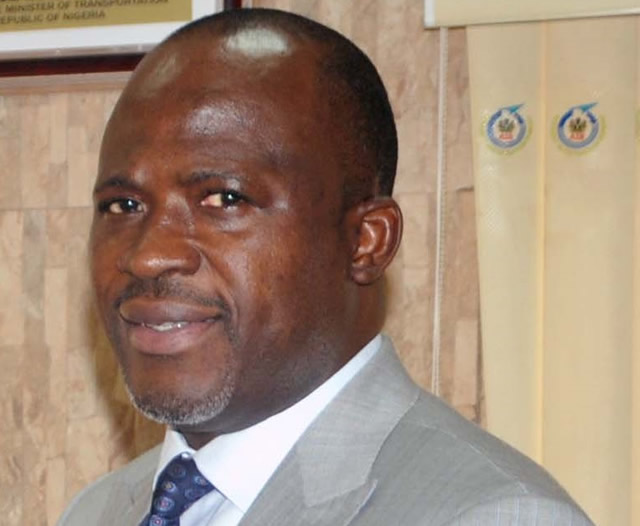The Accident Investigation Bureau (AIB) has released six final accident and serious incident reports that occurred in the Nigeria aviation industry between 2009 and 2014.
Speaking at a media briefing, the AIB Commissioner, Engr. Akin Olateru said that among the six reports were those of two accidents and four serious incidents.
According to Olateru the accidents were: Associated Aircraft crash on October 3, 2013 with the registration number, 5N-BJY and Westlink Airlines Limited Piper Aztec 23-250 aircraft with the registration number 5N-BGZ, which occurred at Matseri Village,Bunza Local Government Area of Kebbi State on August 11, 2014.
The serious incidents according to the AIB boss, were Aero Contractor’s DHC-8-400 aircraft incident with registration 5N-BPT, with the Nigerian Aviation Handling Company (NAHCO) baggage loader on April 29, 2014 and those that involved two Bristow Helicopters aircraft, Bell 412 helicopters with Registration numbers 5N-BGS, and 5N-BDD, at the Addax Base Helipad, Calabar, Cross River State, Nigeria on 12th November, 2009.
Also covered in the reports were the serious incidents that involved two aircraft belonging to Nigerian College of Aviation Technology (NCAT). The affected aircraft were the Tampico Club TB9 with the registration number 5N-CBE, which serious incident occurred at Zaria Aerodrome, Kaduna State on October 4, 2012 and another serious incident involving Tampico TB–9 Aircraft with registration number 5N-CBI that occurred at the same Zaria Aerodrome on May 23, 2012.
Olateru said the bureau was committed to prompt release of accident reports to realise the purpose of accident investigation. notified of the Associated crash through a phone call by the Nigerian Civil Aviation Authority (NCAA) immediately after the accident.
It would be recalled that the associated aircraft crashed on October 3, 2013 shortly after takeoff at Murtala Muhammed Airport, Lagos on a chartered scheduled flight taking the remains of the former Minister of Aviation and Governor of Ondo State, Dr. Olusegun Agugu to Akure for burial.
The aircraft crashed with 20 souls on board out of which 16 deaths and four survivors were recorded,
Giving details of the accident in a 170 page final report tagged: Aircraft Accident Report ASSOC/2013/10/03/F AIB stated that causal factor of the crash was linked to the decision of the crew to ignore safety warning. That is the flight crew did not abort the flight despite the abnormal number 2 Propeller indication warning and the low altitude stall as a result of low thrust at start of roll for take-off from number 2 engine caused by an undetermined malfunction of the propeller control unit.
On the contributory factor, the AIB’s release fingered the aircraft being rotated before attaining V1, the level an engine velocity must attain before takeoff, the decision to continue the take-off with flap configuration warning and auto-feather warning at low speed, poor professional conduct of the flight crew, inadequate application of Crew Resource Management (CRM) principles, failure of the flight to work as a team during flight, poor company culture and inadequate regulatory oversight.
To this effect and to mitigate future occurrence of similar accident, the AIB released four safety recommendations on the crash, which were all directed at Nigerian Civil Aviation Authority (NCAA) with the call on NCAA to enhance the enforcement of the regulations with regards to the implementation of operators approved personnel training programme and intensification of its safety oversight function on the airline to ensure that flight operations were carried out in accordance with approved operations manuals in line with the provisions of Nigeria Civil Aviation Regulations (NCARs).
Others recommendations were, improved safety oversight on the affected carrier to ensure staff welfare issues, and that remunerations were settled promptly and the establishment of Confidential Voluntary Reporting System, which must be implemented in line with the State Safety Program.
On the two Bristow Helicopters serious incidents at the Addax Base Helipad, Calabar in Cross River State on November 12, 2009, like Associated Airlines’, the bureau also made four safety recommendations.
It recommended that the regulatory agency should ensure that Calabar Base Helipad Manual of APDNL be reviewed to comply with Nigeria Civil Aviation Regulations (NCARs), APDNL should ensure that helicopters are properly parked in designated locations, APDNL should ensure that Helicopter Landing Officers (HLOs) are always present during aircraft operations and the agency should ensure that helicopter flight operations at the Helipad were done in accordance with Nig. CARs.
AIB in the report, however, stated that NCAA responded to the safety recommendations of the bureau and implemented them.
On the Aero Contractors incident with NAHCO aviance baggage loader vehicle fleet L3-23 and a parked Bombardier DHC-8-400 aircraft of Aero Contractors,
AIB in its report said the NAHCO personnel who operated the baggage loader vehicle was neither employed to operate the vehicle, nor was he authorised to do so.
The report observed that the rostered driver of the baggage loader vehicle was not available at the time of the occurrence and cited the non-adherence to NAHCO Safe Operating Procedures by the Ramp manager as one of the contributory factors to the incident.
It also made four safety recommendations to NCAA, which included ‘strict adherence to NAHCO’s Standard Operating Procedures’ and ‘Air Operators’ Certificate (AOC) holders should determine the minimum number of personnel for airline ground handling operations to be deployed for each aircraft type.’
On the Westlink Airlines’ Piper Aztec 23-250 aircraft accident, AIB identified inadequate visual lookout and failure to avoid the obstacle by the pilots as the only causal factor responsible for the accident.
The contributory factors included less than adequate planning and preparation for the flight, inadequate pilot training and experience on agricultural aerial work and limited regulatory guidance and oversight on agricultural operations.
It also made four safety recommendations to NCAA in its report.
The report also included two NCAT serious incidents that occurred on May 23, 2012 and October 4, 2012 in Kaduna State, which generated eight safety recommendations.


